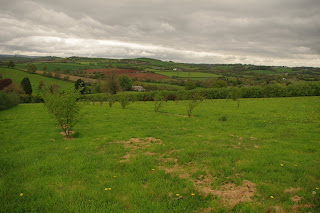A.R.T. part two. After Martin Crawford showed us the forest garden greenhouse he took us round the rest of the site.
Adjacent to the greenhouse he is developing a low growing garden using forest gardening principles -without the tree canopy- as a prototype for smaller gardens. Living in London that's an approach I find particularly interesting. There is little scope for planting fully fledged forests in urban areas but there are many domestic gardens and public spaces.
Strawberry plants carpet the ground; there isn't a patch of bare soil anywhere.
The Littlehempston site is exposed to the elements (that's the edge of Dartmoor on the horizon). Two forest garden staples form long hedgerow windbreaks: Sea Buckthorn (Hippophae spp.) and Autumn Olive (Elaeagnus umbellata). The former bears berries rich in vitamin C, the latter dark red fruits that can be eaten raw or cooked. Both are valued for their nitrogen fixing properties.
The hedges provide some shelter for several large scale plantings. The top photo shows the start of a new forest garden canopy layer. The yellow flowered Brooms are 'nursery plants', which Martin notes is a strategy used in forestry but not agriculture. Shrubs create shelter while the trees establish themselves.
The second photo shows a planting of hazel in wide rows that will allow for 'alley cropping' i.e. combining agroforestry with polycultures of crops in strips. Elsewhere there are plantings of a nut orchard and experimental coppices i.e. trials of trees that are food producing and suitable for coppicing and pollarding. Martin is something of an authority on nut trees but points out there is no point planting them for food production in a locale where there are squirrels!
The Littlehempston site is also where Martin does all his propagation and runs a mail order/internet business selling forest garden plants. Part three to follow...






